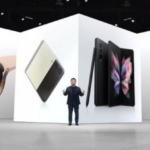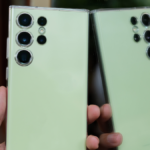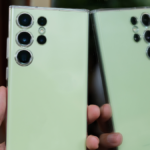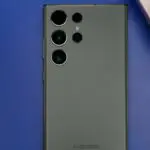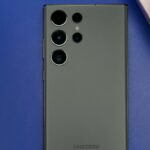“You get what you pay for” is one of the oldest adages in the English language. Either in the context of something ultra-cheap, or – here – of something super-expensive, with the new Samsung Galaxy S8+ coming in at £779 inc VAT in the UK and similar top end prices across the world. Yet, after spending a week with the S8+ I am forced to admit that you do get an awful lot for your money. Whether you enjoy using all the tech depends, as usual, on how much you like Samsung – its sometimes quirky designs, its software, its ecosystem – and, in this case, how much you’re prepared to experiment with new ways of unlocking your phone.
The Galaxy S8+ (and the smaller S8, identical apart from the obvious, plus battery size) are very definitely ‘quirky’ (to put it kindly), or ‘flawed’ (to put it more critically), but this shouldn’t take away from Samsung’s achievement in getting the S8+ to market. This phone screams ‘from the future’ in terms of design and build, even managing to make the also super-sleek LG G6 look like last year’s device. In fact, put it next to anything else from 2016, say even Samsung’s own problematic Note 7, and the latter looks utterly ‘retro’.
Pick up the S8+ and roll it around in your hands and it’s super-sleek, super-solid. It’s like finding an alien object, fallen from space and polished smooth by centuries of space dust abrasion – there are no sharp edges. That the time and date (or, optionally a calendar or photo) are glowing gently from underneath the hard, jet black Gorilla Glass 5 is something of a tech wonder. Everything is kept minimal and subservient to this smooth design. Is this really from the same company that made the plasticky, tacky Galaxy S5 only three years ago?

There are downsides to the full-on glass surfaces, of course. There’s the inevitable need to keep the Galaxy S8+ in a protective TPU or leather case in case of drops, meaning that you’ll only really ever get to feel the emotions above on day one, as thereafter it’ll be housed inside something very definitely man made and less ‘spacey’.
You only need to protect against drops and shocks though, since Samsung has – impressively – managed to make the S8 range IP68-compliant, so completely water and dust proof. This is one bullet point that’s always worth seeking out in the phone world.
Samsung calls the 6.2” 18.5:9 ‘WQHD+’(!) AMOLED screen an ‘Infinity Display’ and it’s easy to see where the moniker comes from. It’s larger and more colourful and higher contrast and more immersive than any phone display I’ve ever seen.

When you’re using Android, virtual controls at the display’s bottom and the Android status bar at the top frame your content in traditional fashion, though when an application (e.g. watching media) takes control of the whole screen it’s like that moment in a cinema when the side panels pull away and everything suddenly gets bigger and wider.
Well, that’s the theory anyway – most streaming media is still at 16:9 and will be for some time, so you’ve often got black bars either side of such content, though Samsung has thought of this and compensated though making the fascias of each S8 or S8+ – whatever its colour – black, so that the sidebars meld seamlessly into the phone’s frame. Then, if you’re happy to forego a little content top and bottom of frame and don’t mind a little ‘stretching’, there’s a ‘Crop to fit’ button lurking on the right of the screen when playing video material, this is compromised but does at least use all of the giant display, as shown below.

Having mentioned ‘virtual controls’, these are an obvious departure for Samsung, which has previously clung rigidly to an iPhone-copying physical home button, usually accompanied by its trademark capacitive menu/recent apps and back controls. The button had to go, of course, given the display aspirations here, though the change has meant that you can now have the controls whichever way round you want – i.e. back can now be on the left, as on most other Android phones, if you want it this way.

Although there’s no physical home button, Samsung detects hard presses on the bottom centre of the display, via small distortions in the glass, and this kicks in what the old button used to do, i.e. brings up the lockscreen and notifications. It’s accompanied by a haptic pulse from the phone’s vibrator, though this is delayed very slightly from the press and this ruins the illusion of a physical press – maybe this can be sped up in a future update.
Because of the need to be pressed in this way and because of the need to curve the glass extensively, there’s something of a gap underneath it. Causing ‘crackling’ sounds every now and then as I picked up the phone and applied any pressure. This might be just my review model but I wouldn’t be surprised if it was generic – this is what I’d expect from so much glass, so curved and with no obvious supporting rim.
The back of the S8+ is curved in the same way, i.e. symmetrically, though I did note that the rear glass doesn’t have an oleophobic coating applied. Making it not as slippery, but with the downside that it gathers fingerprints like they’re going out of fashion. This is a no win situation for Samsung, since an oleophobic back would have made the phone unusably slippery. Not that any of this is an issue since the S8/S8+ will be a in case 24/7.
The Samsung logo is now on the back of the phone but looks perfectly at home there, along with the usual camera cluster, with the main camera now perfectly flush and just a small raised metallic ring to protect it from scratches. The thinner camera module doesn’t seem to have affected results too much, thankfully, as we’ll see later.

Biometrics
The oddity, and the design decision that has caused the most controversy, is the positioning of the fingerprint sensor off to one side of the camera lens, though level with it. In practice this means that even after much practice you’ll end up putting your greasy fingerprints on at least some of the camera glass every time you try to unlock your phone this way – it’s a long way to stretch the index finger for a right handed user.
The back story, famously, is that Samsung wanted to put the sensor under the main display but couldn’t get the tech working in time, so had to fall back on plan B in order to ship the S8/S8+ on time. This is eminently plausible and I can imagine the frustration in Samsung’s design teams as they had to make the fateful compromise here.
For you and I, the user, the placement means that unlocking with a fingerprint isn’t trivial or easy or quick and there’s a significant chance that you’ll smudge up the camera glass in the process, something which Samsung warns about with a pop-up dialog when you first train the sensor. In fact, this is so worrisome that I found myself contorting my finger slightly so as to avoid the camera glass each time and, as a result, fingerprint recognition was impaired. Sigh.
So… we move to an alternative method of unlocking the Galaxy S8+ – iris recognition. This was pioneered on the Lumia range by Microsoft a couple of years ago and is faster here on the S8 range but it’s still just as flawed as it was in 2015.


The iris recognition works fine if you don’t wear glasses. If you do, or if you have contacts then your mileage will vary. Hugely. And I cannot BELIEVE that Samsung is suggesting that people remove their contact lenses every time they want to unlock their screen this way!!
A front facing camera and infrared LED light up your irises as you bring the phone up in front of your face – if all goes well then the iris pattern (unique to you) will be recognised and you’ll be authenticated and in. Unfortunately, the system falls down if you wear glasses (as I do) – varifocals (again, me) are the worst, distorting the patterns and, unsurprisingly, recognition doesn’t work.
So we move on to strike three, face recognition. This was tried back in 2013 on the Google Nexus 4 and it never really took off – partly because it required a certain range of good light conditions and angles to work and partly because it wasn’t that secure – a photo of your face can unlock the phone better than the real thing under some conditions. So with 2017’s security concerns it’s a sign that Samsung was getting pretty desperate in order to have brought this old chestnut back.
Then there are the usual PIN, pattern and password unlocks, curiously more in favour on the S8 now because of the flawed nature of the previous three authentication methods. You can bet that the fingerprint sensor will be properly centred and lower down on the Galaxy S9’s back, but in the meantime it’s compromises all round.
And yes, all of this does take away some of the ‘shiny, shiny’ wonder of the S8 design as a whole. It’s a true Achilles heel, given that there are (literally) hundreds of far cheaper Android phones with very decent specs which have convenient, sensibly placed and reliable fingerprint sensors.
Internals
Under the hood is the powerful Exynos 8895 chipset with 4GB of RAM, with 64GB internal storage (though only 50GB free out of the box) plus microSD on the pop-out SIM tray if needed. The Qualcomm X16 LTE modem is rated at 1 Gbit/s, so up to 100MB per second transfer over cellular data. Gulp. That’s what you call future proofing!
The Galaxy S8+ is fast, though you always get the impression navigating around the UI that the ‘Samsung Experience’ skin is slowing things down… just a little. More on the Samsung software in a moment.
Having had the Note 7 battery fiasco in 2016, where physical constraints on the battery proved disastrous, Samsung has played it relatively safe with the Galaxy S8+, with only a 3500mAh battery even in this tall phone frame. I’m sure they’ve factored in battery expansion and allowed huge margins of error this time round. Battery life isn’t an issue though, with Android 7’s own battery optimisations added to by some aggressive ‘sleeping’ of background applications by Samsung’s own algorithms. Combined, getting through a busy day with the Galaxy S8+ is easy.
And if you do need a top-up then charging is pretty easy too. A standard (for 2017) USB Type C port on the bottom of the phone is QuickCharge 2.0 compatible (though not 3.0, interestingly, at least with current firmware). And as an additional safety measure from Samsung, note that fast charging doesn’t work while the screen is powered on (i.e. you’re using the phone) – we’ve all tried using a phone while it’s being charged in the past and noticed how warm the electronics get from the double activity, so this is just Samsung being ‘better safe than sorry’ – if a single Galaxy S8 catches fire for any reason then Samsung really is in trouble.

Qi and PMA wireless charging coils are also provided, should charging pad top-ups during the day be convenient for you. Plenty of options anyway.
Also down at the bottom is a solitary speaker of decent volume and fidelity. However, I’ve already commented on LG missing a trick on the G6 by pairing a wonderful HDR display with mono sound and the same applies here. The extra-wide Galaxy S8+ is crying out for a stereo speaker pair. Even a kludged implementation as on the HTC phones (stereo, but split between tweeter and woofer) would have helped. But no, all the sound comes out of the bottom/right of the device, the grille is easy to block, and there’s simply no stereo satisfaction. Again, it’s a missed opportunity, especially in a high cost flagship – even the budget ZTE Axon 7 mini, at a third the cost has great stereo front-facing speakers, so there’s really no excuse for missing this aspect of smartphone-based entertainment.
One consolation will be that right next to the USB Type C port and speaker is a 3.5mm audio jack. Apple jumped the gun by getting rid of this on the iPhone 7 range (as did a few Android manufacturers who copied it) and it’s good to see Samsung staying with what works. Being able to listen to music while charging one’s phone is actually darned common and darned useful. Who knew?(!)
Samsung bundles some excellent little AKG braided headphones – these have good bass and general fidelity and are a world apart from the earphones Samsung used to bundle. Well done all round – I really enjoyed headphone audio from the S8+.

Imaging
Despite the S8+ camera being as flush as the LG G6’s, Samsung has done a much better job at compensating for the thin camera unit in software. The 12MP f/1.7 wide-ish angle lens is backed by a 1/2.5” ‘dual pixel auto-focus’ sensor and OIS, all very capable, but the biggest impact is in software, with Google Pixel-like multi-frame processing. So, instead of taking just one photo at a time, a burst of at least three shots is always taken (though the shutter noise only sounds once, obviously) and then these are averaged and optimised, computing out digital noise and artefacts while also allowing for genuine subject movement.
Samsung don’t quite take this to the same lengths as Google’s Pixel with the HDR+ software, but the presence of the insanely fast focussing dual pixel system and optical OIS makes up the difference. This could well be the best all round phone camera in the world right now – I’ve seen higher image quality on some of my Microsoft Lumias but they’re left in the dust in terms of speed, consistency and convenience. Credit to Samsung here – even my usual complaint about over-sharpening of photos is tempered by this having been reigned in for the S8 range.
Some terrific photos then on the S8+, see below for some samples (at maximum resolution, at 4:3) and 1:1 crops with comments.



Decent details here in overcast conditions, good colours and not too over-sharpened



In this HDR shot, there’s decent contrast brought out from a church which was largely in shadow to my eyes. See the bird on top of the cross here – I hadn’t spotted that!



Still under cloudy skies, decent detail again. Samsung stays JUST the right side of over-sharpening most of the time.



Nice detail on this clock face, indoors. You can see the sharpening and edge enhancement if you look very closely. But this is being extremely picky!



In VERY low light (two candles) here, the sharpening lens the shot a slightly artificial flavour at the pixel level. But the impact at full size is tremendous, there’s little to complain about here.



At dead of night, the black sky becomes dark blue and everything’s lighter than it was to my eyes, thanks to the use of OIS and a long shutter time. The multi-frame processing keeps digital noise down to acceptable levels too.
Video is optically stabilised and optionally electronically stabilised too, at up to 4K and with good stereo audio capture and that same lightning fast focus as with stills. Allied to the great screen, even outdoors, from all angles and – provided you have the phone in a secure case – the Galaxy S8+ makes for a compelling casual camcorder. Samsung even provides a ‘Movie Maker’ utility for stitching together video clips and images along with various visual and music styles – create something fun and quick on the fly, etc.
The front camera is 8MP and also excellent, but I’m not going to affront you, gentle reader, with more shots of my ugly mug, so you’re going to have to take my word for the selfie capability.
Bixby
I did omit one button from the hardware rundown above – and it’s on the left of the phone and only has one function. It launches Bixby, Samsung’s new personal digital assistant. As of now it’s just a placeholder for some news, weather and PIM reminders, alongside a ‘Bixby Vision’ utility that’s supposed to recognise products and find them online for err… buying again. The former is good enough but doesn’t really improve on Google’s traditional Now screens on other phones, while the latter failed on the things I tried it out with in the UK.


‘Responds to voice’? Well, not yet in most of the world. Bixby is current very hobbled, doing a lot less than the Google Assistant and stock features. Samsung’s vision for it is, literally, all-encompassing, though, so it’ll be interesting to revisit this in, say, six months.
Now, Samsung’s vision is to have just about everything on the phone controlled by voice via Bixby. As in “Send the four latest photos to Jim with subject line ‘Last night’s party’”. Which is slower than actually using the touch UI but hey, you might be driving or otherwise not able to use the touchscreen. Or you must just be lazy!
It’s an interesting and all-encompassing voice vision and way beyond what Google’s Assistant (also included here!) aims to do, but it’s just that – a vision, an ambition. It’s very much still born here on the Galaxy S8 range in almost all world markets and languages and the decision to hard-wire a button on the phone to something which isn’t remotely ready can only be described (in “Yes, Minister” fashion) as ‘courageous’(!)


Annoyingly, a Bixby Vision advert pops up far too often when all I’m trying to do is take a photo. Samsung, I know Bixby’s there. so stop bugging me.
Interestingly, the Hello Bixby home page can be brought up even when the phone is locked – possibly very convenient though note that quite a few items in the Bixby scope need the phone unlocking, so it’s really only a way to see latest headlines and weather.
I’m prepared to give Samsung the benefit of the doubt with Bixby though – they surely believe in their vision here, so let’s see what voice magic that extra button can conjure up by (say) Autumn 2017.
The Samsung Experience
TouchWiz, widely hated (by geeks) and loved (by regular users), became ‘Grace UX’ a year ago, with Samsung trying to play down the bad name that the former UI had garnered in the tech press. And now it’s seemingly just ‘The Samsung Experience’, which is a very apt name to describe just everything about the Galaxy S8 and S8+.


Most of the S8+ interface retains features from earlier models (e.g. S7 edge), with the Samsung Edge panels ‘gimmick’. I say that because I’ve never met a Samsung Galaxy owner who uses this set of side-swiped shortcuts. We already have homescreens, we have an app drawer, do we really need (for example) the ‘Apps Edge’ here? The other main set of slide-over icons are for contacts and maybe, just maybe, these might be useful to some, rather than digging into the Phone app.
The bloat and gimmicks from (for example) the S5 days are massively scaled down now, with most of the gestures and options neatly packaged in Settings and with most of the Samsung first party applications only ‘suggested’ installs when you go through the set-up sequence and it’s trivial to say ‘No thanks’. You still get Samsung Health, the ‘Internet’ browser (useful for its ad blocking but most people will still use Chrome, I suspect), ‘Email’ (hey, not everyone uses Gmail) and Gallery, but the Samsung application stable isn’t forced on every user, thankfully. And if you do fancy grabbing some of those apps anyway then they’re under a ‘Galaxy apps’ mini-store.


If you say ‘no’ to the first question in the phone set-up then your Samsung apps folder is relatively restrained, as here. If you feel like you missed out, there’s always ‘Galaxy Apps’!
In the same fashion as on Google’s Pixels, the app drawer here is brought up with a swipe within the homescreen UI and there are the usual Samsung grid sorting and ordering options. As with many other app launchers, all icons are sanitised within a ‘Squircle’ outline, but this only occasionally looks ‘wrong’.


As usual on a Galaxy phone, sign into your Samsung account and you get Samsung’s services along for the ride, never mind that a lot of it duplicates what Google provides to all Android phones. (right) he default app drawer population, including also a Google and Microsoft folder. Which all makes sense, even if most people will want to do a lot of fiddling around after purchase.
Somewhat oddly, Samsung has implemented a completely different long-press menu for homescreen (and app drawer) icons to Google with its latest Pixel devices. Google’s version is more like Apple’s, with a deep dive into common actions for that application, whereas Samsung’s here is more about application control and placement. I prefer Google’s much more sophisticated implementation, but Samsung users will get on just fine here too, looking to remove a shortcut or uninstall and app, etc.
As is the current trend on Android, there’s a built-in clean-up wizard in the guise of ‘Device Maintenance’ in Settings. This gives a score for how ‘clean’ a regular user’s phone is, along with a big ‘Optimise now’ button. There’s even an anti-malware scanner here. Plus this is your way into fiddling with the three power saving presets: off, mid and max, with each reducing screen resolution and applying increasingly drastic limits to the processor and running applications.

Yes, screen resolutions – the full WQHD+ mode is frowned on by default, with everything running in 1080p, or ‘FHD+’, as it’s known here. This saves around 25% on power and you really can’t tell in terms of pixellation of the interface, even on the giant 6.2” display here. Why did Samsung put in the 1440p mode then? For DayDream VR use, no doubt, where even this high resolution is on the low side. The resolution switching is a fair compromise and I have to be honest, even 720p on this lovely Samsung screen looked pretty darned good. And the fewer the pixels to throw around, the longer the battery will last. 1080p is a good default here.


By default the S8+ runs at 1080p and this is perfectly fine. Then, in the future, VR software will temporarily override this and run the screen in full 1440p mode. Is it worth accepting the lower default? Heck yes, 25% more battery life! (right) The screen resolution lowering is part of the various power saving modes too – these are really well thought out by Samsung, even if you only use them on long days out when you’re actually worried about making it to bedtime.
The ‘Always on display’ is excellent on the S8 range, powered as it should be by an AMOLED screen. You get a choice of clock styles, from digital to (my favourite) ‘analogue’, from world clock to calendar, and more. Plus notification icons, showing what’s come in since you last cleared things down. I’ve loved such ‘Glance’ displays since Nokia introduced them around a decade ago and this is perhaps the best implementation yet. And with the time on-screen all the time, there’s not even a need to reach down to touch or press anything to get this information.


The Settings have been reworked again, but I loved the ‘Looking for something else?’ section at the bottom of many panes – it’s hard to remember where are the settings are, so this – plus the search box, top right – makes it a doddle to find a setting you’re looking for. (right) I can’t handle switching screen colours modes in day to day life – I’m just too busy. So leave it on ‘Adaptive’ and forget it. The bottom slider might be useful if your device’s AMOLED white isn’t quite ‘white’ enough, I guess?!
Talking of displays, the Galaxy S8+ has the option of the Samsung DeX dock and onwards connection to a large external display, but I didn’t get a chance to test this in the review period and this accessory deserves a review of its own at some point. Watch this space.

Verdict
The Galaxy S8+ is certainly a stunning piece of smartphone design. It’s fundamentally flawed, of course – the mass of fragile glass that needs protecting, the fixed-use Bixby button, the awkward biometrics – but it’s going to be very influential going forwards. Not just for other manufacturers to copy, but also for Samsung’s own Galaxy S9 in 2018, which is sure to be faster again, have fully working voice control and a fingerprint sensor underneath the main display. That will be a sure fire recommendation, but it’s harder to be so definite with this year’s version.
Not that anyone who buys the S8+ can really complain – there’s an insane amount of technology here and implemented so prettily. If you remember the very first Galaxy Note, it had a 5.3” screen diagonal and the phone was 83mm wide. This S8+ has a significantly larger display yet is only 73mm wide and a hundred times more manageable in the hand.
The LG G6 is the more well-rounded smartphone to recommend to your friends, but the S8 and S8+ still get my personal pick overall as ultimately being more capable in the imaging, audio and charging departments. Plus it has the best display on any phone in history – period.
https://www.youtube.com/watch?v=h5jdoGCysVs
Thanks to Clove for the review Galaxy S8+.


